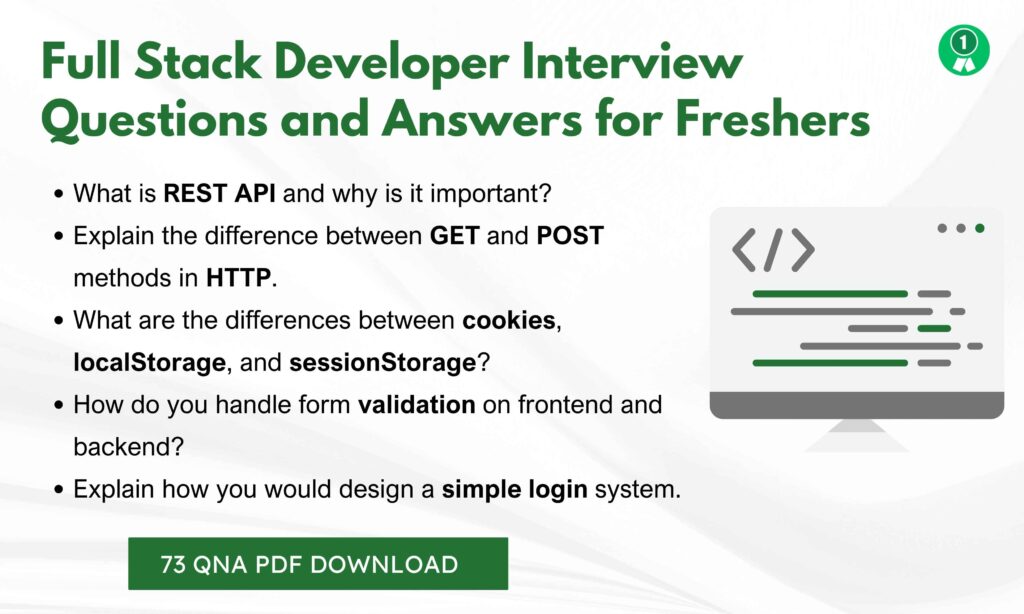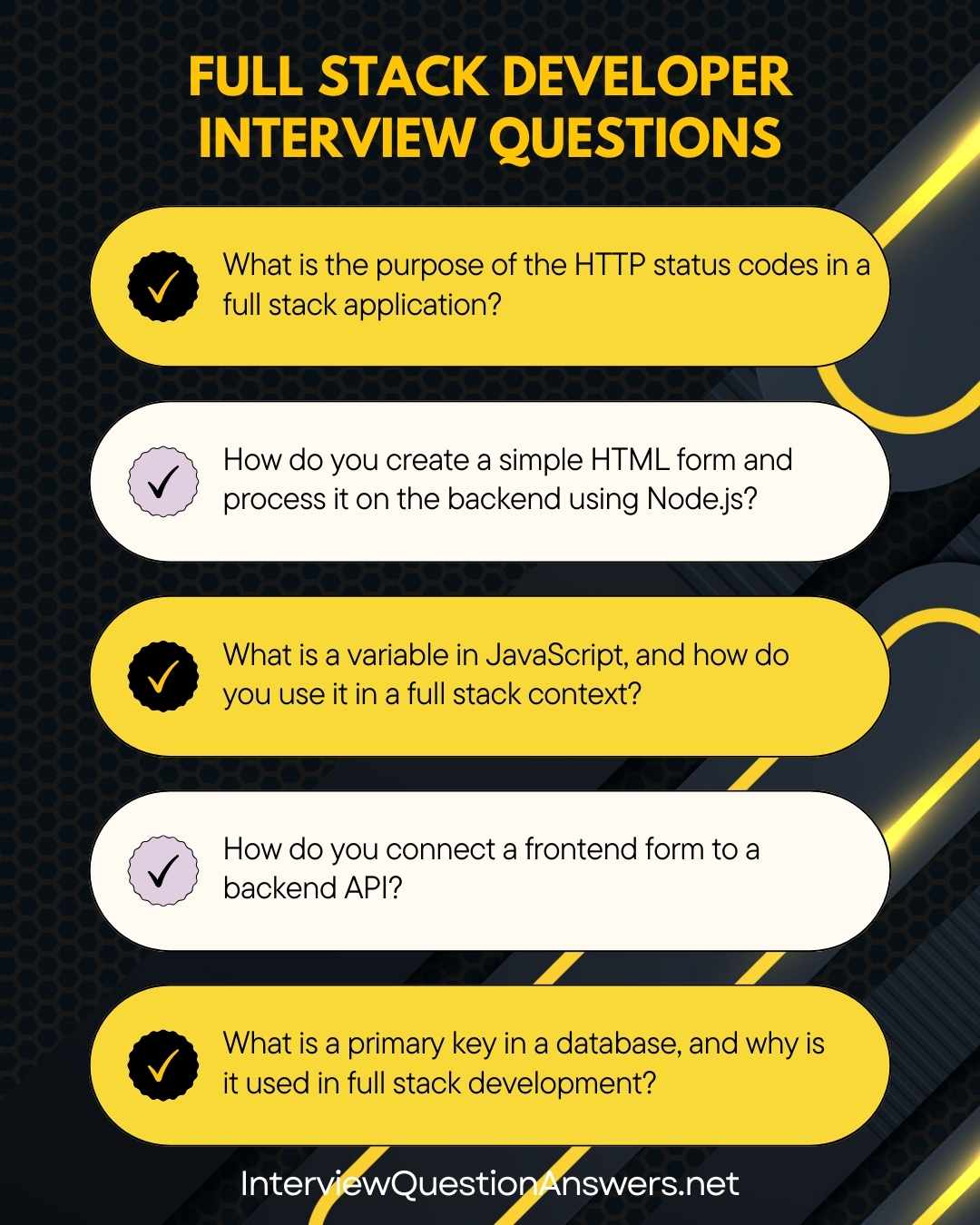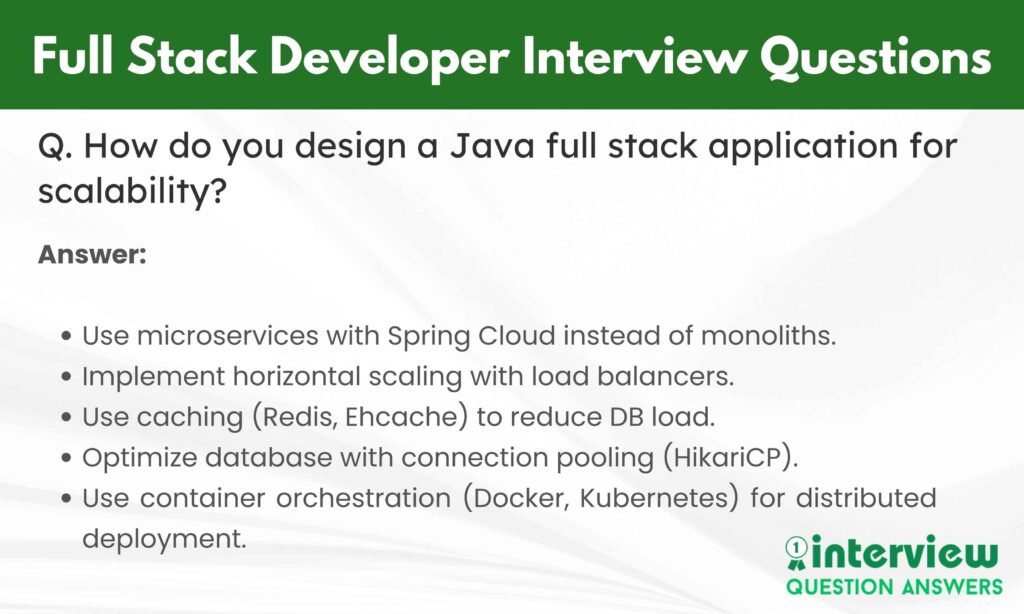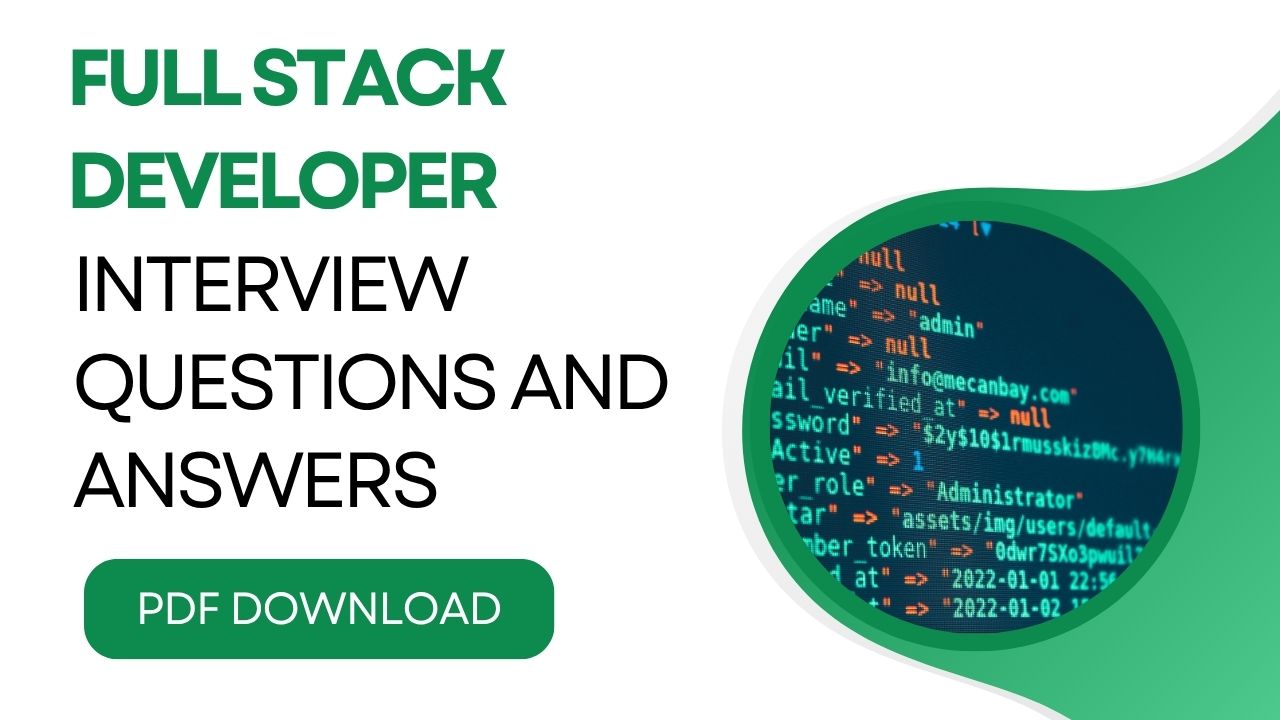Full-stack developers are versatile professionals who bridge the gap between front-end and back-end development, possessing expertise in both client-side and server-side technologies to build complete web applications from start to finish.
They handle everything from user interface design and user experience to database architecture, server management, and API integration, making them invaluable assets in today’s fast-paced development environment.
As companies increasingly seek developers who can work across the entire technology stack, the competition for full-stack positions has intensified significantly, making comprehensive interview preparation essential for success.
This comprehensive guide features Full Stack Developer Interview Questions and Answers for both fresher and experienced full-stack developers. Beyond general full-stack concepts, we have also included dedicated sections with specialized questions for Java, .NET, and Python full stack interview questins with answers.
Table of Contents
Full Stack Developer Interview Questions and Answers for Freshers
Que 1. What are the core technologies you should know as a Full Stack Developer?
A Full Stack Developer should be proficient in:
| Technology Area | Examples |
|---|---|
| Frontend | HTML, CSS, JavaScript, React, Angular, Vue.js |
| Backend | Node.js, Express, Django, Spring Boot, .NET |
| Database | MySQL, PostgreSQL, MongoDB, Redis |
| Version Control | Git, GitHub |
| Other Skills | REST APIs, basic cloud deployment (AWS, Azure), DevOps basics |
Que 2. What is the difference between SQL and NoSQL databases?
- SQL Databases: Structured, use tables, rows, and columns. Examples: MySQL, PostgreSQL.
- NoSQL Databases: Unstructured or semi-structured, store data as documents, key-value pairs, or graphs. Examples: MongoDB, Cassandra.
Use SQL for complex queries and relationships, NoSQL for flexibility and scalability.
Que 3. What is REST API and why is it important?
REST API (Representational State Transfer) is an architectural style that uses HTTP methods (GET, POST, PUT, DELETE) to interact with resources.
- It makes communication between frontend and backend easier.
- It is stateless, scalable, and supports multiple data formats (JSON, XML).
Que 4. Explain the difference between GET and POST methods in HTTP.
- GET: Used to fetch data, parameters are sent in the URL, and it’s idempotent.
- POST: Used to send data to the server, parameters are sent in the request body, and it’s not idempotent.
Example:
GET /users?id=1
POST /usersQue 5. What is the difference between synchronous and asynchronous programming in JavaScript?
- Synchronous: Tasks run one after another, blocking the main thread.
- Asynchronous: Tasks run independently, and the result is handled later (via callbacks, promises, or async/await).
Example: fetch() is asynchronous, alert() is synchronous.
Que 6. What are the differences between cookies, localStorage, and sessionStorage?
- Cookies: Stored on the client and sent with every request; size ~4KB.
- localStorage: Stores data permanently until manually cleared; size ~5MB.
- sessionStorage: Stores data only for the session; size ~5MB.
Que 7. What is CORS and why do we need it?
CORS (Cross-Origin Resource Sharing) allows browsers to access resources from a different origin (domain). Without CORS, browsers block requests for security reasons. Backend servers must send specific headers like:
Access-Control-Allow-Origin: *Que 8. Explain MVC architecture in web applications.
- Model: Handles data and business logic
- View: Handles UI and presentation
- Controller: Handles user requests and connects the Model and View
This separation improves scalability and maintainability.
Que 9. What are some ways to improve website performance?
- Minify and bundle CSS/JS
- Use CDN for static assets
- Implement caching (browser, server, CDN)
- Optimize images (WebP, compression)
- Lazy load heavy components
- Use pagination for large datasets
Que 10. What is JWT (JSON Web Token) and how is it used for authentication?
JWT is a token-based authentication mechanism containing three parts: Header, Payload, and Signature. It is sent in the request headers (usually Authorization) to verify the user identity without storing session data on the server.
Que 11. What are the differences between SSR and CSR?
| Feature | SSR (Server-Side Rendering) | CSR (Client-Side Rendering) |
|---|---|---|
| Rendering Location | Server | Client (browser) |
| Initial Load Speed | Faster | Slower |
| SEO Friendliness | Better (search engines can easily index content) | Poorer (requires extra steps for SEO) |
| Use Case Example | Next.js | React SPA |
| Best For | Static or content-heavy websites needing SEO | Dynamic and interactive web applications |
Que 12. How do you handle form validation on frontend and backend?
- Frontend: Validate input using HTML5 attributes or JavaScript.
- Backend: Always validate again for security using libraries like Joi (Node.js) or built-in frameworks validation.
Que 13. What are the advantages of using a framework like Express or Django for backend?
- Faster development with built-in features (routing, middleware, ORM)
- Security best practices (XSS, CSRF protection)
- Large community and plugins support (required, pattern)
- Better structure for scalable apps
Que 14. How does a browser render a webpage?
- Browser parses HTML and builds DOM
- Parses CSS and builds CSSOM
- Combines DOM and CSSOM into a Render Tree
- Performs layout and painting to display the page
JavaScript execution can block this process if not optimized.
Que 15. What is the difference between PUT and PATCH in HTTP methods?
- PUT: Replaces the entire resource with new data.
- PATCH: Updates only the specified fields.
Example:
PUT /user/1 --> Send entire user object
PATCH /user/1 --> Send only the field(s) to updateQue 16. How would you secure a web application?
- Use HTTPS everywhere
- Validate and sanitize user input (to prevent SQL Injection/XSS)
- Implement authentication and authorization properly
- Use security headers (Content-Security-Policy, X-Frame-Options)
- Keep dependencies updated
- Rate-limit APIs to prevent abuse
Que 17. What are WebSockets and when would you use them?
WebSockets provide a full-duplex, persistent connection between the client and server. They are ideal for real-time applications like chat apps, gaming, or stock tickers. Unlike HTTP, it doesn’t need to make a request for every update.
Que 18. Explain how you would design a simple login system.
- Frontend: Create a login form with email & password
- Backend: Verify user credentials against the database
- Security: Hash passwords using bcrypt
- Token: Generate a JWT and send it to the client
- Storage: Store token in httpOnly cookie or localStorage
- Authorization: Validate the token on protected routes
Que 19. How would you handle scalability for a growing web application?
- Use load balancers
- Implement horizontal scaling (multiple servers)
- Use database replication and sharding
- Cache frequently accessed data using Redis or Memcached
- Implement microservices architecture when needed
Que 20. What steps would you take to debug a Full Stack application issue?
- Frontend: Check browser console logs, inspect network requests
- Backend: Check server logs, use debugging tools (like console.log , breakpoints)
- Database: Test queries directly, check for errors or slow queries
- End-to-end: Use tools like Postman or automated tests to isolate the issue
Document the issue and fix incrementally to avoid breaking other parts of the system.

Also Check: Web Development Interview Questions
Que 21. How do you create a simple REST API endpoint in Flask?
Answer:
Use Flask to define routes for HTTP methods. Example:
from flask import Flask, jsonify
app = Flask(__name__)
@app.route('/api/users', methods=['GET'])
def get_users():
return jsonify([{ 'id': 1, 'name': 'Alice' }])
app.run(port=5000)Que 22. What is the role of CSS in a full stack application?
Answer:
CSS styles the frontend, controlling layout, colors, and responsiveness of the UI. It enhances user experience by making pages visually appealing and adaptive to devices.
Example:
.container {
display: flex;
justify-content: center;
}Backend serves CSS files or integrates with frontend frameworks.
Que 23. How do you select an element by ID in JavaScript for a full stack app?
Answer:
Use document.getElementById() to manipulate DOM elements based on backend data.
Example:
fetch('/api/data')
.then(res => res.json())
.then(data => {
document.getElementById('output').textContent = data.message;
});Backend:
app.get('/api/data', (req, res) => {
res.json({ message: 'Hello World' });
});Que 24. What is a foreign key, and how is it used in a full stack app?
Answer:
A foreign key links tables by referencing a primary key in another table, maintaining relationships. In full stack, it’s used to fetch related data (e.g., user orders).
Example (SQL):
CREATE TABLE orders (
id INT PRIMARY KEY,
user_id INT,
FOREIGN KEY (user_id) REFERENCES users(id)
);API retrieves orders for a user:
app.get('/orders/:userId', (req, res) => {
// Query orders by user_id
});Que 25. How do you validate user input on the frontend in a full stack app?
Answer:
Validate inputs using HTML attributes (required, pattern) and JavaScript for custom checks before sending to the backend.
Example:
const form = document.getElementById('form');
form.addEventListener('submit', (e) => {
const email = form.email.value;
if (!email.includes('@')) {
e.preventDefault();
alert('Invalid email');
}
});Backend re-validates for security.
Que 26. What is a boolean, and how is it used in full stack development?
Answer:
A boolean is a true/false value used for conditional logic. In full stack, it controls UI states (frontend) or business logic (backend).
Example:
// Frontend
let isLoggedIn = true;
if (isLoggedIn) document.getElementById('welcome').style.display = 'block';
// Backend
app.get('/check', (req, res) => {
res.json({ isActive: true });
});Que 27. How do you handle JSON data in a full stack application?
Answer:
Frontend sends/receives JSON via fetch. Backend parses/sends JSON with frameworks like Express.
Frontend:
fetch('/api', {
method: 'POST',
body: JSON.stringify({ name: 'Bob' }),
headers: { 'Content-Type': 'application/json' }
}).then(res => res.json());Backend:
app.post('/api', (req, res) => {
res.json({ received: req.body.name });
});Que 28. How do you connect a Node.js backend to a MongoDB database?
Answer:
Use mongoose to connect and query MongoDB. Example:
const mongoose = require('mongoose');
mongoose.connect('mongodb://localhost/mydb');
const User = mongoose.model('User', { name: String });
app.get('/users', async (req, res) => {
const users = await User.find();
res.json(users);
});Que 29. What is the purpose of a route in a backend framework?
Answer:
A route maps an HTTP request (method + URL) to a handler function. In Flask:
@app.route('/api/data', methods=['GET'])
def get_data():
return jsonify({ 'data': 'Hello' })Frontend calls the route via fetch.
Que 30. How do you create a responsive layout with CSS in a full stack app?
Answer:
Use CSS media queries, Flexbox, or Grid to adapt layouts to screen sizes.
Example:
.container {
display: grid;
grid-template-columns: repeat(auto-fit, minmax(200px, 1fr));
}
@media (max-width: 600px) {
.container { grid-template-columns: 1fr; }
}Backend serves the styled page or API data.
Que 31. What is the purpose of the HTTP status codes in a full stack application?
Answer:
HTTP status codes indicate the result of a client’s request to the server. Common codes include 200 (OK, successful request), 404 (Not Found, resource missing), 400 (Bad Request, invalid input), 500 (Internal Server Error), and 201 (Created, resource added). In full stack, the backend sends these codes in API responses, and the frontend interprets them to display appropriate messages or handle errors.
Example in Express:
app.get('/user', (req, res) => {
if (!user) return res.status(404).json({ error: 'User not found' });
res.status(200).json(user);
});Que 32. How do you create a simple HTML form and process it on the backend using Node.js?
Answer:
Create an HTML form with input fields and a submit action, then handle it on the backend with Express. Use body-parser to parse form data.
Frontend:
<form action="/submit" method="POST">
<input type="text" name="name" required>
<button type="submit">Submit</button>
</form>Backend:
const express = require('express');
const bodyParser = require('body-parser');
const app = express();
app.use(bodyParser.urlencoded({ extended: true }));
app.post('/submit', (req, res) => {
const name = req.body.name;
res.send(`Hello, ${name}`);
});Que 33. What is a variable in JavaScript, and how do you use it in a full stack context?
Answer:
A variable in JavaScript stores data (e.g., strings, numbers) using let, const, or var. In full stack, variables hold data like user inputs on the frontend or API responses on the backend.
Example:
// Frontend
let user = 'Alice';
document.getElementById('name').textContent = user;
// Backend (Node.js)
const express = require('express');
const app = express();
app.get('/api', (req, res) => {
const data = { user: 'Alice' };
res.json(data);
});Que 34. How do you connect a frontend form to a backend API?
Answer:
Use fetch or axios on the frontend to send form data to a backend API endpoint. Handle the response to update the UI.
Frontend:
const form = document.getElementById('myForm');
form.addEventListener('submit', async (e) => {
e.preventDefault();
const data = { name: form.name.value };
const response = await fetch('/api/submit', {
method: 'POST',
headers: { 'Content-Type': 'application/json' },
body: JSON.stringify(data)
});
const result = await response.json();
console.log(result);
});Backend (Express):
app.post('/api/submit', (req, res) => {
res.json({ message: `Received ${req.body.name}` });
});Que 35. What is a primary key in a database, and why is it used in full stack development?
Answer:
A primary key uniquely identifies each record in a database table, ensuring data integrity and enabling efficient queries. In full stack, it’s used to link data (e.g., users to orders) and retrieve records via APIs.
Example (SQL):
CREATE TABLE users (
id INT PRIMARY KEY AUTO_INCREMENT,
name VARCHAR(50)
);Frontend fetches by ID:
fetch(`/api/users/1`).then(res => res.json());
Also check: Full Stack Developer Interview Questions for Freshers
Full Stack Developer Interview Questions and Answers for Experienced
Que 36. How do you design a scalable architecture for a high-traffic web application?
For high-traffic applications, you should:
- Use load balancers to distribute traffic across multiple servers.
- Implement horizontal scaling using containers (Docker, Kubernetes).
- Cache data at different levels (CDN, reverse proxy, in-memory stores like Redis).
- Optimize database with replication, partitioning, and connection pooling.
- Use asynchronous processing (message queues like RabbitMQ or Kafka).
Que 37. What are microservices and how do they differ from monolithic architecture?
- Microservices: Independent, loosely coupled services communicating over APIs.
- Monolithic: Single codebase handling all modules tightly coupled together.
Microservices provide better scalability, independent deployments, and fault isolation. Monoliths are simpler but harder to scale and maintain.
Que 38. How do you handle state management in a distributed system?
- Use stateless services whenever possible.
- Persist state in distributed caches (Redis, Memcached) or databases.
- For sessions, use shared stores (Redis, DynamoDB) instead of in-memory sessions.
- Apply sticky sessions only if necessary.
Que 39. Explain database indexing and its impact on performance.
Indexes improve query performance by creating a fast lookup path. However, they slow down write operations (INSERT, UPDATE, DELETE) and consume storage.
Example:
CREATE INDEX idx_users_email ON users(email);Always analyze query patterns and avoid over-indexing.
Que 40. How do you handle API versioning in a live application?
- Use versioned endpoints like /api/v1/ and /api/v2/.
- Maintain backward compatibility and deprecate older versions gradually.
- Use feature flags for experimental features.
- Document all versions using OpenAPI/Swagger.
Que 41. What is the difference between optimistic and pessimistic locking?
- Optimistic Locking: Assumes no conflicts; validates version numbers before committing.
- Pessimistic Locking: Locks data at read time to prevent conflicts.
Optimistic locking is better for high-read/low-write systems; pessimistic is suitable for high-contention environments.
Que 42. How would you secure sensitive data at rest and in transit?
- In Transit: Use HTTPS/TLS for all communications.
- At Rest: Use AES encryption for database fields or files.
- Apply key management policies (e.g., AWS KMS, HashiCorp Vault).
- Hash sensitive data like passwords using bcrypt or Argon2.
Que 43. How do you improve the performance of a slow API endpoint?
- Profile queries and use proper indexing.
- Implement caching at DB, application, and response levels.
- Use pagination instead of fetching large datasets.
- Break heavy tasks into asynchronous jobs.
- Reduce payload size (Gzip, Brotli, or GraphQL partial queries).
Que 44. How do you handle deployment and rollback strategies in production?
- Blue-Green Deployment: Keep two environments and switch traffic after testing.
- Canary Deployment: Release to a small user segment before full rollout.
- Keep previous builds ready for instant rollback.
- Automate deployment pipelines with CI/CD tools (Jenkins, GitHub Actions).
Que 45. What are some advanced caching strategies you have used?
- Write-through cache: Write to cache and DB simultaneously.
- Write-back cache: Write to cache first, then DB asynchronously.
- Cache invalidation policies: TTL (Time-To-Live), versioning, and manual invalidation.
- Layered caching with CDN + in-memory + database-level caching.
Que 46. How do you implement rate limiting and throttling in APIs?
- Use middleware like NGINX rate limit, API Gateway policies, or libraries like
express-rate-limit. - Strategies: Token bucket, leaky bucket, fixed window, sliding window.
- Return
429 Too Many Requestswhen limit is reached.
Que 47. How do you design a database schema for scalability?
- Normalize for consistency, then denormalize for performance when necessary.
- Use partitioning/sharding for large datasets.
- Avoid heavy joins by designing for read patterns.
- Choose appropriate data types and constraints.
Que 48. How do you debug memory leaks in a Node.js or Java application?
- Use tools like Chrome DevTools, heap snapshots, Node’s –inspect, or
jmap(Java). - Look for objects retained in memory unexpectedly.
- Monitor GC (Garbage Collection) metrics.
- Fix by removing unused listeners, closing DB connections, and clearing caches.
Que 49. How do you handle distributed transactions in microservices?
- Use the Saga pattern (choreography or orchestration).
- Use eventual consistency with retries and compensating actions.
- Avoid 2-phase commits in high-scale systems due to complexity.
Que 50. Explain the difference between horizontal and vertical scaling.
- Horizontal scaling: Add more servers/instances to handle load.
- Vertical scaling: Increase hardware capacity (CPU/RAM) on a single server.
Horizontal scaling is more fault-tolerant and cost-effective in the long run.
Que 51. How do you design a logging and monitoring system for full-stack applications?
- Centralize logs with tools like ELK Stack, Graylog, or Splunk.
- Implement structured logging (JSON format).
- Use metrics and dashboards with Prometheus, Grafana, or Datadog.
- Add alerting based on thresholds and anomalies.
Que 52. How do you optimize frontend performance for large applications?
- Code splitting and lazy loading using Webpack or Vite.
- Minify and tree-shake unused JS/CSS.
- Use image optimization (WebP, responsive images).
- Reduce re-renders in React/Vue by using memoization.
Que 53. How do you design a CI/CD pipeline for full-stack applications?
- Automate builds, tests, and deployments.
- Use tools like Jenkins, GitHub Actions, or GitLab CI.
- Include security scans and code quality checks.
- Support multiple environments (dev, staging, production).
Que 54. How do you ensure high availability and fault tolerance in production?
- Deploy across multiple availability zones or regions.
- Use load balancers and health checks.
- Implement circuit breakers and retries in APIs.
- Ensure databases have replicas and automatic failover.
Que 55. How would you architect a real-time collaborative application (like Google Docs)?
- Use WebSockets or WebRTC for real-time communication.
- Maintain an operational transform (OT) or CRDT-based data structure for conflict resolution.
- Persist updates in a distributed database.
- Ensure scalability with message brokers like Kafka for broadcasting changes.
Que 56. How do you implement a GraphQL API in a full stack application with Apollo Server and React?
Answer:
Use Apollo Server on the backend to define a GraphQL schema and resolvers, and Apollo Client on the frontend (React) for queries/mutations. Example:
Backend (Node.js with Apollo Server):
const { ApolloServer, gql } = require('apollo-server');
const typeDefs = gql`
type User { id: ID, name: String }
type Query { users: [User] }
`;
const resolvers = {
Query: { users: () => [{ id: 1, name: 'Alice' }] }
};
const server = new ApolloServer({ typeDefs, resolvers });
server.listen(4000);Frontend (React with Apollo Client):
import { useQuery, gql } from '@apollo/client';
const GET_USERS = gql`query { users { id name } }`;
function Users() {
const { data } = useQuery(GET_USERS);
return data ? data.users.map(user => <div key={user.id}>{user.name}</div>) : <div>Loading...</div>;
}This reduces over-fetching compared to REST, improving performance for complex UIs.
Que 57. What is the role of WebSockets in a full stack application, and how do you implement them with Node.js and React?
Answer:
WebSockets enable real-time, bidirectional communication (e.g., for chat apps). Use ws in Node.js and WebSocket API in React.
Backend:
const WebSocket = require('ws');
const wss = new WebSocket.Server({ port: 8080 });
wss.on('connection', ws => {
ws.on('message', message => ws.send(`Echo: ${message}`));
});Frontend:
useEffect(() => {
const ws = new WebSocket('ws://localhost:8080');
ws.onmessage = e => console.log(e.data);
ws.send('Hello');
return () => ws.close();
}, []);Ensures low-latency updates for real-time features.
Que 58. How do you optimize database queries in a full stack application for a high-traffic system?
Answer:
Optimize with indexing (e.g., B-tree for range queries), query batching, and caching (Redis). Use EXPLAIN in SQL to analyze query plans. Example in PostgreSQL:
CREATE INDEX idx_user_email ON users(email);
SELECT * FROM users WHERE email = 'user@example.com';Frontend caches results with react-query. Reduces query time by 50-70% in high-traffic apps.
Que 59. How do you implement authentication with OAuth 2.0 in a full stack application?
Answer:
Use an OAuth provider (e.g., Auth0) with a backend (Spring Boot) and frontend (React). Backend validates tokens; frontend handles login flow.
Backend:
@Configuration
public class SecurityConfig {
@Bean
public SecurityFilterChain filterChain(HttpSecurity http) throws Exception {
http.oauth2ResourceServer(OAuth2ResourceServerConfigurer::jwt);
return http.build();
}
}Frontend:
import { useAuth0 } from '@auth0/auth0-react';
function Login() {
const { loginWithRedirect } = useAuth0();
return <button onClick={loginWithRedirect}>Log In</button>;
}Ensures secure, scalable authentication.
Que 60. How do you handle file uploads in a full stack application with Node.js and React?
Answer:
Use multer for uploads on Node.js and FormData on React. Store files in cloud storage (e.g., S3).
Backend:
const multer = require('multer');
const upload = multer({ dest: 'uploads/' });
app.post('/upload', upload.single('file'), (req, res) => {
res.json({ file: req.file });
});Frontend:
const handleUpload = async e => {
const formData = new FormData();
formData.append('file', e.target.files[0]);
await fetch('/upload', { method: 'POST', body: formData });
};Handles large files efficiently with streaming.
Que 61. How do you implement a circuit breaker pattern in a full stack application?
Answer:
Use Resilience4j (backend) to prevent cascading failures, with frontend fallbacks. Example in Spring Boot:
@CircuitBreaker(name = "api", fallbackMethod = "fallback")
public String callApi() {
return restTemplate.getForObject("http://external-api", String.class);
}
public String fallback(Throwable t) {
return "Fallback data";
}Frontend (React) shows fallback UI:
const { data, error } = useQuery('api', fetchApi);
if (error) return <div>Fallback UI</div>;Improves reliability under external failures.
Que 62. How do you ensure cross-browser compatibility in a full stack application?
Answer:
Frontend: Use polyfills (core-js), Autoprefixer for CSS, and test with BrowserStack. Backend: Return consistent API responses. Example:
// .babelrc
{ "presets": [["@babel/preset-env", { "targets": "defaults" }]] }Backend ensures JSON consistency across browsers. Achieves 95%+ browser coverage.
Que 63. What is the role of containerization in full stack development, and how do you use Docker?
Answer:
Containerization (Docker) ensures consistent environments. Define services in Dockerfile and docker-compose.yml.
Example:
FROM node:16
WORKDIR /app
COPY package.json .
RUN npm install
COPY . .
CMD ["npm", "start"]services:
app:
build: .
ports:
- "3000:3000"
db:
image: postgresSimplifies deployment and scaling.
Que 64. How do you implement rate limiting in a full stack application?
Answer:
Backend: Use express-rate-limit or Redis-based limiting. Frontend: Show rate limit errors.
Backend:
const rateLimit = require('express-rate-limit');
app.use(rateLimit({ windowMs: 60000, max: 100 }));Frontend:
fetch('/api').catch(err => {
if (err.status === 429) alert('Too many requests');
});Prevents abuse, ensures fair usage.
Que 65. How do you handle database migrations in a full stack application?
Answer:
Use Flyway (Java) or Sequelize (Node.js) for migrations. Backend applies migrations; frontend adapts to schema changes.
Example (Flyway):
-- V1__create_users.sql
CREATE TABLE users (id INT PRIMARY KEY, name VARCHAR(50));Frontend updates queries for new fields. Ensures zero-downtime updates.
Que 66. How do you implement real-time notifications in a full stack application?
Answer:
Use WebSockets (Socket.IO) for real-time updates. Backend pushes notifications; frontend listens.
Backend:
const io = require('socket.io')(server);
io.on('connection', socket => {
socket.emit('notification', { message: 'Update' });
});Frontend:
import io from 'socket.io-client';
useEffect(() => {
const socket = io('http://localhost:3000');
socket.on('notification', data => console.log(data));
return () => socket.disconnect();
}, []);Ideal for alerts or live feeds.
Que 67. How do you optimize a full stack application for SEO?
Answer:
Use SSR (Next.js) for crawlable HTML, add meta tags, and optimize load times. Backend serves prerendered pages; frontend hydrates.
Example (Next.js):
export async function getServerSideProps() {
return { props: { title: 'My App' } };
}
function Page({ title }) {
return <Head><title>{title}</title></Head>;
}Improves search rankings with fast TTFB.
Que 68. How do you handle logging in a full stack application?
Answer:
Backend: Use Winston (Node.js) or Log4j (Java) for structured logs. Frontend: Log errors to console or send to backend.
Backend:
const winston = require('winston');
const logger = winston.createLogger({
transports: [new winston.transports.File({ filename: 'app.log' })]
});
logger.info('API called');Frontend:
window.onerror = (msg) => fetch('/log', { method: 'POST', body: JSON.stringify({ msg }) });Centralize with ELK for analysis.
Que 69. How do you implement a search feature in a full stack application?
Answer:
Backend: Use Elasticsearch for full-text search or SQL LIKE for simple queries. Frontend: Display results dynamically.
Backend (Express):
app.get('/search', async (req, res) => {
const results = await db.query('SELECT * FROM products WHERE name LIKE ?', [`%${req.query.q}%`]);
res.json(results);
});Frontend:
const [results, setResults] = useState([]);
fetch(`/search?q=${query}`).then(res => res.json()).then(setResults);Scales with Elasticsearch for large datasets.
Also check: Full Stack Developer Interview Questions for Experienced
Que 70. How do you manage environment-specific configurations in a full stack application?
Answer:
Use environment variables (.env files) for configs like API keys or database URLs. Backend loads with dotenv; frontend uses build-time variables.
Backend:
require('dotenv').config();
const dbUrl = process.env.DB_URL;Frontend (React):
const apiUrl = process.env.REACT_APP_API_URL;Ensures flexibility across dev/staging/prod.
Also Check: Front end Developer and Back end Developer interview Questions Guides
Java Full Stack Developer Interview Questions and Answers
Que 71. What are some common Java frameworks used in full stack development and why?
- Spring Boot: Simplifies backend development with auto-configuration and embedded servers.
- Hibernate/JPA: Provides ORM for database access.
- Spring Security: Handles authentication and authorization.
- Thymeleaf: Used for server-side rendering.
- Frontend frameworks: Angular, React, or Vue.js commonly used for UI.
These frameworks speed up development, provide ready-to-use modules, and improve maintainability.
Que 72. How does Spring Boot simplify backend development compared to traditional Spring?
Spring Boot eliminates boilerplate configurations by using auto-configuration and opinionated defaults. It includes an embedded Tomcat/Jetty server, enabling applications to run as standalone JARs. It also provides an Actuator module for monitoring and health checks, making it faster to build production-ready services.
Que 73. What are RESTful APIs in Spring Boot and how do you implement them?
RESTful APIs follow the REST architecture, using HTTP methods to interact with resources. Example:
@RestController
@RequestMapping("/api/users")
public class UserController {
@GetMapping("/{id}")
public User getUser(@PathVariable Long id) {
return userService.findById(id);
}
}This exposes /api/users/{id} as an API endpoint using GET method.
Que 74. How do you manage state in a Java full stack application?
- Use stateless services as much as possible.
- For sessions, use Spring Session backed by Redis instead of in-memory sessions.
- Store persistent user data in databases and use JWT tokens for authentication.
- Client-side state can be handled using Redux (React) or NgRx (Angular).
Que 75. How do you integrate the frontend (React/Angular) with a Spring Boot backend?
- Expose REST APIs or GraphQL endpoints from Spring Boot.
- Use HttpClient (Angular) or fetch/axios (React) to call APIs.
- Enable CORS in backend:
@CrossOrigin(origins = "*")
@RestController
public class ApiController { }- Use JWT or OAuth2 for secure communication between frontend and backend.
Que 76. How do you handle database transactions in a Java full stack application?
Spring provides the @Transactional annotation to manage transactions:
@Transactional
public void transferFunds(Long fromId, Long toId, BigDecimal amount) {
accountRepository.debit(fromId, amount);
accountRepository.credit(toId, amount);
}This ensures atomicity, rollback on failure, and consistency across multiple operations.
Que 77. What are the best practices for exception handling in Spring Boot applications?
- Use @ControllerAdvice with @ExceptionHandler to centralize error handling.
- Return meaningful error messages with proper HTTP status codes.
- Log exceptions with stack traces using SLF4J/Logback.
Example:
@ControllerAdvice
public class GlobalExceptionHandler {
@ExceptionHandler(Exception.class)
public ResponseEntity<String> handleException(Exception ex) {
return ResponseEntity.status(HttpStatus.INTERNAL_SERVER_ERROR).body(ex.getMessage());
}
}Que 78. How do you secure a Java full stack application?
- Use Spring Security for authentication and authorization.
- Implement JWT or OAuth2 token-based authentication.
- Use HTTPS and configure security headers.
- Validate and sanitize all user inputs to prevent XSS/SQL Injection.
- Encrypt sensitive data using strong encryption algorithms like AES.
Que 79. How do you implement asynchronous processing in Spring Boot?
- Use @Async annotation with @EnableAsync for async methods.
- Use CompletableFuture or message queues like RabbitMQ/Kafka for background processing.
Example:
@Async
public CompletableFuture<String> sendEmail(String to) {
// email sending logic
return CompletableFuture.completedFuture("Email Sent");
}Que 80. How do you design a Java full stack application for scalability?
- Use microservices with Spring Cloud instead of monoliths.
- Implement horizontal scaling with load balancers.
- Use caching (Redis, Ehcache) to reduce DB load.
- Optimize database with connection pooling (HikariCP).
- Use container orchestration (Docker, Kubernetes) for distributed deployment.

Also Check: Java interview Questions and Answers
.Net Full Stack Developer Interview Questions and Answers
Que 81. What are the common technologies used in a .NET full stack application?
A typical .NET full stack application includes:
- Backend: ASP.NET Core (Web API, MVC), Entity Framework Core for ORM.
- Frontend: Angular, React, or Blazor.
- Database: SQL Server, PostgreSQL, or NoSQL databases like MongoDB.
- Authentication: IdentityServer, JWT, OAuth2.
- DevOps: Azure DevOps, Docker, Kubernetes for CI/CD and containerization.
Que 82. How do you create a REST API using ASP.NET Core?
In ASP.NET Core, create a controller decorated with [ApiController] and define endpoints:
[ApiController]
[Route("api/[controller]")]
public class UsersController : ControllerBase {
[HttpGet("{id}")]
public IActionResult GetUser(int id) {
var user = userService.GetById(id);
return Ok(user);
}
}Use dependency injection for services and register them in Startup.cs or Program.cs.
Que 83. How does dependency injection work in ASP.NET Core?
ASP.NET Core has built-in dependency injection (DI). You register services in the container and inject them where needed:
// Registration
services.AddScoped<IUserService, UserService>();
// Usage
public class UsersController {
private readonly IUserService _service;
public UsersController(IUserService service) { _service = service; }
}This improves testability and decouples components.
Que 84. How do you integrate Angular or React frontend with an ASP.NET Core backend?
- Use SPA templates (dotnet new angular or dotnet new react).
- Serve static files from wwwroot or host frontend separately.
- Enable CORS in backend:
app.UseCors(builder => builder.AllowAnyOrigin().AllowAnyMethod().AllowAnyHeader());- Communicate via REST APIs using HttpClient (Angular) or fetch/axios (React).
Que 85. How do you manage database transactions in Entity Framework Core?
Use DbContext and transaction APIs:
using var transaction = await context.Database.BeginTransactionAsync();
try {
context.Users.Add(user);
await context.SaveChangesAsync();
await transaction.CommitAsync();
} catch {
await transaction.RollbackAsync();
}SaveChanges() automatically wraps operations in a transaction if none exists.
Que 86. How do you implement authentication and authorization in ASP.NET Core?
- Use ASP.NET Core Identity for user management.
- Implement JWT token-based authentication for APIs.
- Configure policies and roles:
services.AddAuthorization(options => {
options.AddPolicy("AdminOnly", policy => policy.RequireRole("Admin"));
});- Secure endpoints using [Authorize] attribute.
Que 87. How do you handle exceptions globally in a .NET full stack application?
Use middleware or UseExceptionHandler in Startup.cs:
app.UseExceptionHandler(appBuilder => {
appBuilder.Run(async context => {
context.Response.StatusCode = 500;
await context.Response.WriteAsync("An error occurred.");
});
});For structured error responses, create a custom middleware and log using ILogger.
Que 88. How do you improve performance in a .NET full stack application?
- Enable response caching and use CDN for static files.
- Optimize database with indexes and compiled queries.
- Use asynchronous programming (async/await) for I/O operations.
- Implement caching with MemoryCache or distributed caches like Redis.
- Reduce payload size by using compression middleware.
Que 89. How do you implement real-time communication in .NET applications?
Use SignalR for real-time communication:
public class ChatHub : Hub {
public async Task SendMessage(string user, string message) {
await Clients.All.SendAsync("ReceiveMessage", user, message);
}
}On the frontend, connect using JavaScript or Angular/React SignalR clients to receive updates instantly.
Que 90. How would you design a .NET full stack application for scalability?
- Use microservices with ASP.NET Core and Docker/Kubernetes.
- Implement API Gateway (Ocelot) for routing and security.
- Use horizontal scaling and load balancers (Azure Load Balancer, NGINX).
- Apply distributed caching (Redis) and database sharding.
- Store configuration and secrets in Azure Key Vault or AWS Secrets Manager.
Also Check: C# Interview Questions and Answers
python Full Stack Developer Interview Questions and Answers
Que 91. What are the common frameworks used for Python full stack development?
- Backend: Django, Flask, FastAPI.
- Frontend: React, Angular, Vue.js, or Django’s built-in templates.
- Database: PostgreSQL, MySQL, SQLite, MongoDB.
- Tools: Celery for background tasks, Redis for caching, Docker for containerization.
Que 92. How does Django differ from Flask in full stack development?
- Django: Full-featured, includes ORM, authentication, admin panel, and follows “batteries-included” approach.
- Flask: Lightweight, minimalistic, flexible with external libraries.
Django is better for large-scale apps, while Flask suits smaller, microservice-based applications.
Que 93. How do you create REST APIs in Django or Flask?
In Django, use Django REST Framework (DRF):
from rest_framework.viewsets import ModelViewSet
class UserViewSet(ModelViewSet):
queryset = User.objects.all()
serializer_class = UserSerializerIn Flask, use Flask-RESTful:
from flask_restful import Resource
class UserResource(Resource):
def get(self, user_id):
return {"user": user_id}Que 94. How do you integrate React or Angular frontend with a Django or Flask backend?
- Serve the frontend as static files or host it separately.
- Enable CORS using django-cors-headers or Flask-CORS.
- Consume backend APIs using axios (React) or HttpClient (Angular).
- For production, use a reverse proxy like NGINX to handle both frontend and backend.
Que 95. How do you handle authentication and authorization in Python full stack apps?
- Use Django’s built-in authentication or Flask-Login for session-based auth.
- For token-based auth, use JWT (djangorestframework-simplejwt or PyJWT).
- Implement OAuth2 with libraries like Authlib or django-allauth.
- Secure endpoints using decorators like @login_required or DRF’s Is Authenticated permission class.
Que 96. How do you manage database migrations in Django and Flask?
- Django: Uses built-in makemigrations and migrate commands.
- Flask: Uses Flask-Migrate (based on Alembic). Example:
flask db migrate -m "initial"
flask db upgrade
Migrations ensure database schema is version-controlled and consistent.Que 97. How do you implement background tasks in Python full stack applications?
Use Celery with a message broker (Redis, RabbitMQ):
from celery import shared_task
@shared_task
def send_email_task(user_id):
# logic to send emailSchedule periodic tasks with Celery beat or APScheduler.
Que 98. How do you secure Python full stack applications?
- Always use HTTPS (TLS).
- Validate and sanitize user input to prevent XSS/SQL Injection.
- Use CSRF tokens (csrf_protect in Django).
- Set secure cookies (HttpOnly, Secure, SameSite) .
- Keep dependencies updated and use bandit or safety to scan for vulnerabilities.
Que 99. How would you design a Python full stack application for scalability?
- Break into microservices using FastAPI or Flask for lightweight APIs.
- Use horizontal scaling with Docker + Kubernetes.
- Add caching layers (Redis, Memcached).
- Use database sharding and replication.
- Implement load balancing (NGINX, AWS ALB) and asynchronous message queues.
Que 100. How do you implement real-time features in Python full stack apps?
- Use Django Channels or Flask-SocketIO for WebSocket support.
- Example with Flask-SocketIO:
from flask_socketio import SocketIO
socketio = SocketIO(app)
@socketio.on('message')
def handle_message(msg):
send(msg, broadcast=True)Also Check: Python Interview Questions and Answers
Full Stack Developer Interview Questions PDF
Additionally, we’ve provided a downloadable PDF version, allowing you to study offline and practice at your convenience.
FAQs: Full Stack Developer Interview Questions
What does a Full Stack Developer do?
A Full Stack Developer is responsible for working on both the frontend (user interface) and backend (server, database, and application logic) of web applications. They design, develop, and maintain complete software solutions, ensuring that the user experience, functionality, and performance work seamlessly together.
What skills are required to become a Full Stack Developer?
A successful Full Stack Developer needs strong knowledge of frontend technologies (HTML, CSS, JavaScript, React, Angular), backend frameworks (Node.js, Django, .NET, Spring Boot), databases (SQL, NoSQL), version control (Git), APIs, and cloud deployment. Soft skills like problem-solving, teamwork, and adaptability are equally important.
What challenges do Full Stack Developers face on the job?
Challenges often include managing multiple technologies simultaneously, optimizing performance across the stack, ensuring secure coding practices, and staying updated with rapidly evolving tools. Balancing frontend and backend priorities can also be difficult in fast-paced projects.
What challenges might candidates face during a Full Stack Developer interview?
Candidates can expect technical questions across frontend, backend, databases, and DevOps. They might be asked to solve coding problems, design scalable architectures, or debug existing code. Time management and demonstrating practical experience through projects are key.
What is the average salary of a Full Stack Developer in the USA?
As of recent reports, Full Stack Developers in the USA earn an average salary ranging between $90,000 and $140,000 per year, depending on experience, company size, and location. Senior developers or those with expertise in high-demand technologies can earn more.
Which top companies hire Full Stack Developers?
Major tech companies such as Google, Amazon, Microsoft, Meta, IBM, and Apple actively hire Full Stack Developers. Additionally, startups, SaaS companies, consulting firms, and financial institutions consistently look for skilled professionals for this role.
What is the career growth potential for a Full Stack Developer?
Full Stack Developers have excellent career prospects as they understand the entire development lifecycle. They can grow into senior developer roles, solution architects, product managers, or even CTO positions. With their broad skill set, they are highly valuable in both startups and enterprise organizations.
Also Check:







